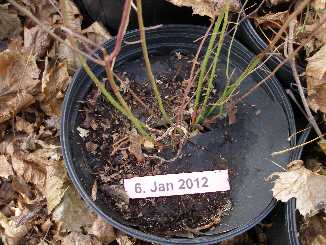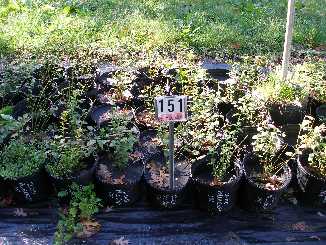

Bluebuy is my catalog of the blueberry bushes we grow for retail sale ($10 each in a three gallon pot) at the flowering shrub farm in Voorheesville, NY. If the picture below doesn't open click here. Scroll down for a list of the blueberry bushes we grow and links to pages dedicated to each variety. We start selling a crop when it is one year old so if the year painted on the side of the pot is last year or older it will be for sale. Scroll down through the list. Explanation of page layout
BLUECROP Crop 151 'Bluecrop' Blueberry bushes (Vaccineum corymbosum).
BLUEJAY Crop 152 'Bluejay' Blueberry bushes. If the picture shows our front porch it means I dont have other pictures at this time. Check during our May inventory.
BLUERAY Crop 153 'Blueray'
University introduced varieties that are extra hardy to zone 3 (all have "North" in their names).
NORTHBLUE Crop 209 Vaccinium 'Northblue' Zone 3, 2.5 feet x 3 feet
NORTHCOUNTRY Crop 213 Vaccinium 'Northcountry' Zone 3, 2 feet x 3 feet
NORTHSKY Crop 211 Vaccinium 'Northsky' Zone 3, 18 inches x 30 inches
Native Lowbush blueberry hardy in zone 2
AITON Crop 212 Vaccinium angustifolium 'Aiton' Lowbush Blueberry Zone 2, 2 feet x 2 feet, Native to Northeastern USA
CULTURAL INFORMATION
I purchase rooted cuttings of one or two of each Blueberry variety from my list above every year and pot them in a three gallon pot using a soiless potting mix (sometimes the mix will have a slow release fertilizer included but that will be depleted within 90 days). Root hardiness of plants is generally fourty degrees less hardy than stem hardiness but as most of these plants are hardy to zone 2, 3 or 4 and we are in zone 5 its usually not a factor. I fertilize each plant in spring with Espoma Holly Tone. On first year plants in three gallon pots that usually translates to a handful of each but as they get larger they need more. We fertilize again after flowering and mulch with compost (each plant is also equipped with a geodisc that sits on top of the mulch and prevents weeds (fertilizer and compost are slipped under the geodisc). Blueberry bushes are usually grown in the field for one season before being brought to the plant sale and sold in a three gallon pot for $10 each (even when they are at the plant sale we will continue to over-write each picture).
Many years ago Dr. Coville of the U.S. Department of Agriculture crossed chosen varieties of the wild Native American Highbush Blueberry Vaccinium corymbosum. The resulting plants are extremely ornamental with their scarlet autumn color and their red twigs in winter. They also produce large quantities of suculent blueberries. All of these original crosses of native blueberries were named with the word blue in the name. The canes may grow 6 to 12 feet in length if left unpruned, the species is generally trouble free and hardier than just zone 4 but sometimes not quite hardy enough to zone 3 (Wyman, 471). If berries are desired we usually keep them pruned to an upright shrub 4 feet by 4 feet. I suggest mulching them in winter at the northern extremes of their range.
These are not hybrids. When a native V corymbosum is crossed with a native V corymbosum the resulting plant is a native V corymbosum. All Dr Coville did was to remove those plants that didn't have large sized berries, scarlet autumn color and large crops of berries. Those left would have naturally crossed with their neighbors on their own. In the second generation by removing from the field again those that didn't have those qualities you wished over several generations you would be left with a number of native plants that are superior berry producers and those you'd name. Then you'd reproduce them from cuttings making them clones of the original named variety but their seeds will pass on these superior traits to your own native crop.
Shrubs and Vines for American Gardens by Donald Wyman, published by The Macmillan Company in London 1969. Library of Congress Catalog card #69-18249
Below is what is in each crop page for blueberry bush varieties.
Closeup picture of the fruit should be on the left and a picture of the available plants on the right. If the picture has a sign with a large number on it, click on the sign in the picture to read when the picture was taken on the pink label, and how many plants we had in stock on the green dot (blueberry bushes are available at the plant sale within one year of being planted). If there are unrelated pictures, they will be replaced as I take pictures of the growing crop.
Availability? Blueberry Bush Guide & Inventory. We grow plants to sell at our plant sale. Go to my growing page to see what we do and when we do it. Read my notes on the zone hardiness numbers I use. Do we do mail order? Check my picture-newsletter Want to purchase? email me.